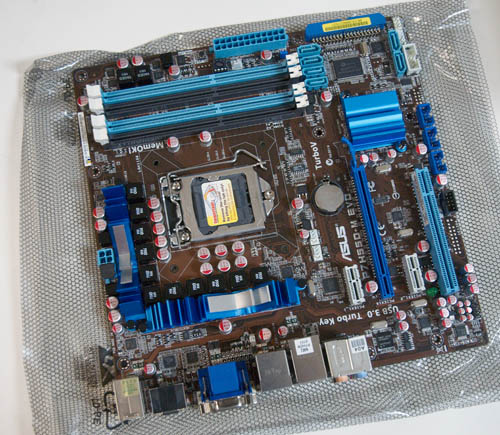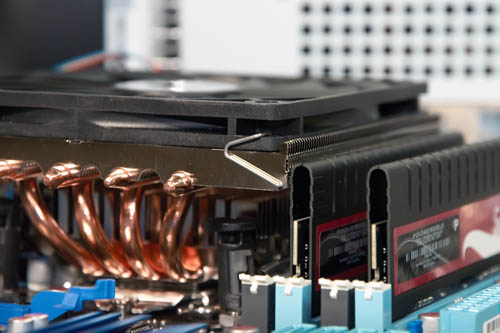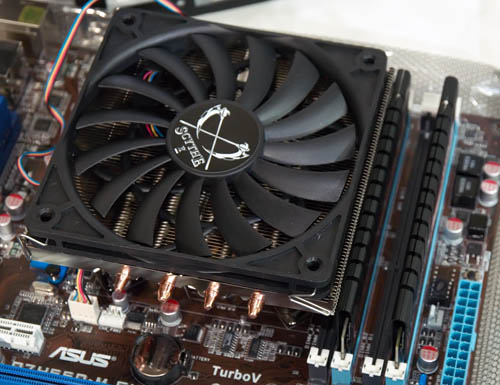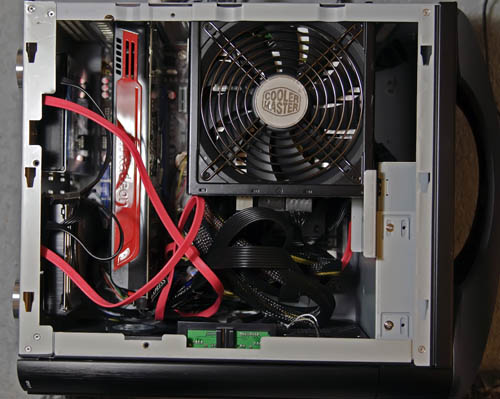The Pain of Assembly
Building a small form factor system is an exercise in flowcharts. If you’re using a highly compact case, like the Silverstone SG04B, the order of assembly is critical. The power supply, for example, goes in last.
The Asus motherboard offers a fairly clean layout, so there’s ample room for a large CPU cooler. However, I discovered late in the game that the SATA ports are poorly located, which means a long graphics card butts up to some of the SATA connectors. The board has plenty of ports, however, and does support USB 3.0, with an onboard NEC USB 3.0 controller.

Attaching the CPU cooler was challenging, too. I’ve generally liked Scythe coolers, but the designers often don’t think about how you actually mount the HSF. The Shiruken is a very low profile cooler, just 58mm high, including the skinny, 120mm fan. However, it’s fairly large, at 4.7 inches square. Plus, the Intel mounting tabs are under the radiator.
All this meant two things: I needed to install the HSF before installing the motherboard in the case.
Installing the cooler was an exercise in patience. I needed a large, flat bladed screwdriver, because there was no way I was going to get my fingers in between the HSF radiator and the top of the mounting pushpin, and still exert enough force to press the connector down until it snapped into place. Even then, I wasn’t 100% sure that all four pushpins had locked down.
And the Patriot memory modules, with their slightly taller silhouette, meant that two of the memory sockets weren’t usable. Lower profile memory modules would have allowed me to install four modules instead of two, if I wanted to go beyond 4GB.


Once the heat sink, CPU and memory were in place, the motherboard slid into the case nicely. It’s definitely a snug fit, since the case is just the right size for a micro ATX motherboard.
The biggest pain, though, was installing the Radeon HD 5850 graphics card. The XFX card is based on the reference design, and is 9.5 inches long. However, the power connectors are on the rear of the card. This had two consequences: you needed to attach the PCIe power plugs before installing the card in the case. Secondly, getting the card into the case meant slipping the card in at an angle, holding cables out of the way, and making sure you didn’t bump SATA or front panel connectors.
Due to the location of the SATA ports, I had to route the SATA cables over the top of the graphics card. Otherwise, I’d need to run them under the card, and that space is already pretty crowded.

The Silverstone case mounts hard drives in the base of the case, which is removable. However, as with the motherboard tray, space is tight, so you need to attach SATA and drive power after you close up the case bottom. I needed to be very careful, as the power adapter and SATA plug have barely enough room. It would be very easy to damage a SATA drive connector.
Once I figured out cable routing and got the graphics card running – which took several cycles of installing and removing the card, then re-routing cables – I booted the system. Everything was good. Installing Windows went smoothly.
The OCZ drive is fast, too. It’s in a 3.5-inch shell, rather than the more common 2.5 inch mechanism, and is really two 128GB modules pre-configured inside the shell for RAID 0. (Users never see the RAID configuration.)










81 Comments
View All Comments
Nfarce - Wednesday, January 27, 2010 - link
+1Yeah, no kidding. WTF *is* the point of this?
"Loyd builds a small form factor, high performance, low power gaming system. Is it worth the effort..."
Dunno, you tell me AT - there is nothing to see here currently.
stromgald30 - Wednesday, January 27, 2010 - link
+1Seriously, this is just a summary of somebody's build. Isn't there a forum for this somewhere?
Articles on the front page should be evaluating something objectively like the case design or benchmarking some components. These articles lack a control/standard (i.e. it's hard to compare the built system / relevant component with a similar or dissimilar build with the same component).
This seems to do very little to help anybody building a SFF other than to make the obvious subjective comment that "it's cramped" and everything is a tight fit. The additional comments about the push pins and motherboard layout seem better suited for motherboard or HSF specific reviews.
tjaisv - Wednesday, January 27, 2010 - link
Agreed.What was the point of this article again? lol
And if somebody had $2000 to spend on a new system i highly doubt they'd be using a core i5 in it anyway.
Griswold - Wednesday, January 27, 2010 - link
For people, such as you, who either buy pre-built machines or ask for a shopping list on the forums, there is nothing (yet) to see there.Why not read the last sentecne of the article again?
Flunk - Friday, January 29, 2010 - link
My desktop is a small formfactor high performance system in a similar Silverstone case that I build over 2 years ago, I know several people with similar systems. They're not unusual enough for an article like this, certainly not "experimental".Penti - Wednesday, January 27, 2010 - link
This should be posted as a blog post.therealnickdanger - Wednesday, January 27, 2010 - link
"Why not read the last sentecne of the article again?"Why not just wait a couple weeks and give us a real review when it's over? AT has built a reputation for being thorough and objective - this preview provides neither. How about compiling benchmarks on the system he built compared to the $900 version he suggests building? As it stands, the article offers no compulsive evidence of any kind, ultimately serving no purpose as an Anandtech review... not even a preview, really.
jamesadames12 - Wednesday, February 3, 2010 - link
http://www.asdpoolsupply.com/pages.php?pageid=11">http://www.asdpoolsupply.com/pages.php?pageid=11mcbowler - Friday, April 2, 2010 - link
There is no reason for a large case anymore. I built a micro-atx PC, however, not quite as small as the silverstone. I put a 5870 and some cheaper AMD AthlonII X3 in it and the thing handles games like a champ. Would have loved to put the SSD in it but its not needed. Here is the case I used. I think a 5970 will fit too.http://www.newegg.com/Product/Product.aspx?Item=N8...
Can't wait to see AMD's vision of its Black Fusion PC come to life.
kondor999 - Monday, May 10, 2010 - link
I built a similar system, but much more powerful:- Same Case.
- Antec Quattro 1000w ($139 after rebate at Fry's).
- EVGA P55 Micro SLI mobo ($84 after rebate at Newegg).
- Core i5-750 OC to 4.0 Ghz using Corsair H50 water cooler (top 120mm fan used for radiator).
- 2 GTX 480's in SLI (yes, they fit and run cool enough - barely).
- Replaced bottom 120mm fan with a speed-adjustable MFDB one, and attached a Zalman Fan-mate to control speed.
- Used card slot at top of case for an exhaust fan (very helpful, given that heat rises and would otw accumulate at the top of the case).
- Intel G2 SSD 80gb boot drive.
- WD Velociraptor WD6000HLHX 600gb game drive.
If I get more ambitious, I may water-cool the 480's with Danger Den waterblocks and mount a 2-fan rad on the back using a Swiftech radbox-mounted DRIVE heat exchanger/pump/reservoir.
This gives me a complete state-of-the-art system that is actually luggable to LAN parties (or, in my case, to work when I feel like closing my office door and goofing off).
It also happens to blow the doors off the "experimental" system described in the article. Mainly because, in a gaming system, $1000 worth of videocards beats an $850 SSD any day. I spent the money where it really counts.
Yay ;-)